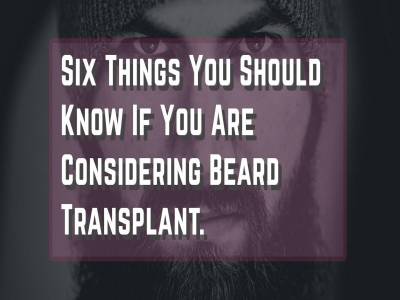Six Things You Should Know If You Are Considering Beard Transplant

Among the facial features in a man that makes him feel and look good is a beard. Many attributes are related to having a beard if you are a man. Women find bearded men attractive and sexy. A man with a full beard is also viewed as strong, authoritative, bold, and responsible. Whatever you choose to believe about bearded men, the fact remains that bearded men are held highly in society.
You don't need to look down on yourself if you can't grow facial hair, as there are several hair loss treatments used to restore hair. You just need to pick the right procedure. So, which of all the hair loss is the best? The best hair restoration procedure allows you to restore hair and restores your hair permanently and naturally. That beard hair loss procedure is called beard transplant.
To help you make an informed decision before choosing a particular hair loss treatment, here are six things you need to know about the beard transplant procedure.
How Beard Transplant is Done
Once the doctor has examined you and has accepted that you are the right candidate for the beard transplant procedure, you need to know how he will perform the beard transplant treatment. Most surgeons use the most effective way when transplanting beards is the FUT (follicular unit transfer). The FUT approach of beard transplant involves removing about 2000 hair follicles and transplanting them to the beard area. This number is ideal for achieving the right texture and coverage. The area where the hair is extracted is known as the donor area. The donor area contains full and healthy hair. Since the back of the scalp hardly suffers from hair loss, it makes an ideal donor area. After locating the donor area, the doctor determines the hair growth pattern and direction by making small incisions in the beard area. To reduce discomfort and pain, the doctor uses local anesthesia. The removed hair grafts are then placed inside the made incisions.
The Patient Supplies the Donor Hair
Infections are reduced by harvesting graft hair from the patient's donor area and transplanting them in the recipient area. As we mentioned above, the scalp's back makes a perfect donor area because it contains healthy hair follicles. Once these hair follicles are harvested and implanted in the recipient area, they will start growing permanent thick hair. Another reason doctors use the patient's hair is to ensure that the beard has the same texture, consistency, and color. This helps to achieve a more natural look.
The Time it Takes to Perform a Beard Transplant
Depending on the doctor's facial hair transplant approach, a full beard transplant may take about 8 to 10 hours. Research first for a reputable clinic or doctor who offers credible treatments will determine the outcome of the beard transplant procedure. The recovery time will take several weeks to start seeing new beards start growing after the grafts have fallen out.
Expectation After the Beard Transplant Procedure
Once the procedure is done, the patient will notice that the transplanted hair falls out after 15-30 days. This is normal because they are making way for new hair to start growing. In three months, the graft will settle, and the patient will begin experiencing full beard growth. In 9 months, the patient will start maintaining and styling his beard because transplanted hair grows much faster than the original hair.
Ideal Candidates for the Hair Transplant Procedure
There are no special requirements needed for a patient to have a beard transplant procedure. He just needs to be healthy and also have healthy and thick scalp hair. Healthy donor hair will ensure that the transplanted hair follicles also grow thick and healthy beard hair. If you suffer from male pattern baldness, you will have limited beard transplant options. Since insurance companies regard beard transplants as cosmetic, they don't offer covers for such procedures.
Know the Risks and Side effects of the Beard Transplant Procedure
Just like any other cosmetic surgery, there are risks and side effects associated with beard transplant procedures. These risks include inflamed and infected hair follicles when grafts are not handled carefully during the procedure. When the doctor uses the FUT facial hair transplant procedure, it will leave a linear scar.
Conclusion
There is no harm in transforming yourself by having a beard transplant. However, you should talk to your doctor first to know whether it's an ideal procedure for you. Once you have this facial hair transplant, you can't reverse it. Therefore, ensure that this is exactly what you want before going through this facial hair restoration procedure.
- Comment
- Posted by Naman Modi